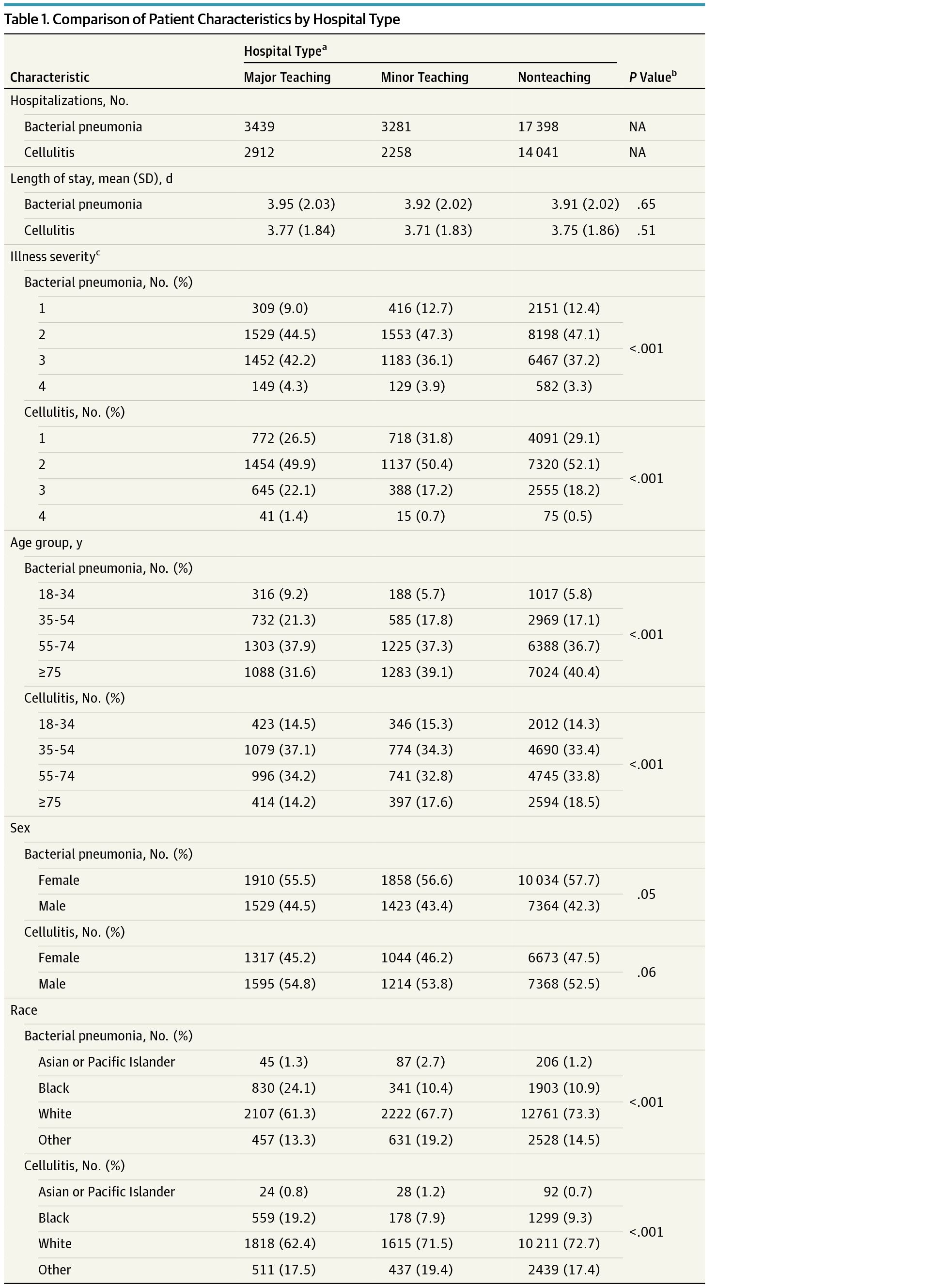当前位置:
X-MOL 学术
›
JAMA Intern. Med.
›
论文详情
Our official English website, www.x-mol.net, welcomes your feedback! (Note: you will need to create a separate account there.)
A Comparison of Laboratory Testing in Teaching vs Nonteaching Hospitals for 2 Common Medical Conditions
JAMA Internal Medicine ( IF 39.0 ) Pub Date : 2018-01-01 , DOI: 10.1001/jamainternmed.2017.6032 Victoria Valencia 1 , Vineet M. Arora 2 , Sumant R. Ranji 3 , Carlos Meza 1 , Christopher Moriates 1
JAMA Internal Medicine ( IF 39.0 ) Pub Date : 2018-01-01 , DOI: 10.1001/jamainternmed.2017.6032 Victoria Valencia 1 , Vineet M. Arora 2 , Sumant R. Ranji 3 , Carlos Meza 1 , Christopher Moriates 1
Affiliation

|
Importance Robust laboratory use data are lacking to support the general assumption that teaching hospitals with trainees routinely order more laboratory tests for inpatients than do nonteaching hospitals. Objective To quantify differences in the use of laboratory tests between teaching and nonteaching hospitals. Design, Setting, and Participants A cross-sectional study was performed using a statewide database to identify hospitalizations with a primary diagnosis of bacterial pneumonia or cellulitis from January 1, 2014, to June 30, 2015, at teaching and nonteaching hospitals with 100 or more hospitalizations of each condition. Patients included were adult inpatients with a primary diagnosis of bacterial pneumonia (n = 24 118) or cellulitis (n = 19 211); patients excluded were those with an intensive care unit stay, transfer from another hospital, or a length of stay that was 2 SDs or more of the condition’s mean length of stay. Main Outcomes and Measures Mean laboratory tests per day stratified by illness severity, as well as factors associated with laboratory use rates. Results A total of 43 329 hospitalized patients (20493 women and 22836 men) had a principal diagnosis of bacterial pneumonia or cellulitis across 11 major teaching hospitals, 12 minor teaching hospitals, and 73 nonteaching hospitals in Texas. Mean number of laboratory tests per day varied significantly by hospital type and was highest for major teaching hospitals for both conditions (bacterial pneumonia: major teaching hospitals, 13.21; 95% CI, 12.91-13.51; nonteaching hospitals, 8.92; 95% CI, 8.84-9.00; P < .001; cellulitis: major teaching hospitals, 10.43; 95% CI, 10.16-10.70; nonteaching hospitals, 7.29; 95% CI, 7.22-7.36; P < .001). This association held for all levels of illness severity for both conditions, except for patients with cellulitis with the highest illness severity level. In generalized mixed linear regression models, controlling for additional patient and encounter covariates, there was a significant difference in the marginal effect of hospital teaching status on mean number of laboratory tests per day between major teaching and nonteaching hospitals (difference in marginal mean laboratory tests per day for bacterial pneumonia, 3.58; 95% CI, 2.61-4.55; P < .001; for cellulitis, 2.61; 95% CI, 1.76-3.47; P < .001). Conclusions and Relevance Compared with nonteaching hospitals, patients in Texas admitted to major teaching hospitals with bacterial pneumonia or cellulitis received significantly more laboratory tests after controlling for illness severity, length of stay, and patient demographics. These results support the need to examine how the culture of training environments may contribute to increased use of laboratory tests.
中文翻译:

教学医院与非教学医院实验室检测对两种常见疾病的比较
重要性 缺乏可靠的实验室使用数据来支持这样一个普遍假设,即与非教学医院相比,有实习生的教学医院通常为住院患者订购更多的实验室检查。目的 量化教学医院和非教学医院在实验室测试使用方面的差异。设计、设置和参与者 使用全州数据库进行了一项横断面研究,以确定 2014 年 1 月 1 日至 2015 年 6 月 30 日期间,在拥有 100每种情况的住院治疗。纳入的患者是初步诊断为细菌性肺炎(n = 24 118)或蜂窝织炎(n = 19 211)的成年住院患者;被排除在重症监护病房的患者,从另一家医院转移的患者,或住院时间是该病症平均住院时间的 2 个标准差或更多。主要结果和测量 按疾病严重程度以及与实验室使用率相关的因素分层的平均每天实验室测试。结果 德克萨斯州 11 家主要教学医院、12 家小型教学医院和 73 家非教学医院共有 43 329 名住院患者(20493 名女性和 22836 名男性)的主要诊断为细菌性肺炎或蜂窝织炎。每天实验室检查的平均数因医院类型而异,主要教学医院在两种情况下最高(细菌性肺炎:主要教学医院,13.21;95% CI,12.91-13.51;非教学医院,8.92;95% CI,8.84 -9.00;P < .001;蜂窝组织炎:主要教学医院,10.43;95% CI,10.16-10.70;非教学医院,7.29;95% CI,7。22-7.36;P < .001)。除了疾病严重程度最高的蜂窝织炎患者外,这种关联适用于两种情况的所有疾病严重程度。在广义混合线性回归模型中,控制了额外的患者和遭遇协变量,主要教学医院和非教学医院之间医院教学状况对每天平均实验室检查次数的边际效应存在显着差异(每人的边际平均实验室检查数差异)细菌性肺炎的天数,3.58;95% CI,2.61-4.55;P < .001;蜂窝织炎,2.61;95% CI,1.76-3.47;P < .001)。结论和意义 与非教学医院相比,在控制了疾病严重程度、住院时间和患者人口统计数据后,得克萨斯州因细菌性肺炎或蜂窝织炎住进主要教学医院的患者接受了明显更多的实验室检查。这些结果支持需要检查培训环境的文化如何有助于增加实验室测试的使用。
更新日期:2018-01-01
中文翻译:

教学医院与非教学医院实验室检测对两种常见疾病的比较
重要性 缺乏可靠的实验室使用数据来支持这样一个普遍假设,即与非教学医院相比,有实习生的教学医院通常为住院患者订购更多的实验室检查。目的 量化教学医院和非教学医院在实验室测试使用方面的差异。设计、设置和参与者 使用全州数据库进行了一项横断面研究,以确定 2014 年 1 月 1 日至 2015 年 6 月 30 日期间,在拥有 100每种情况的住院治疗。纳入的患者是初步诊断为细菌性肺炎(n = 24 118)或蜂窝织炎(n = 19 211)的成年住院患者;被排除在重症监护病房的患者,从另一家医院转移的患者,或住院时间是该病症平均住院时间的 2 个标准差或更多。主要结果和测量 按疾病严重程度以及与实验室使用率相关的因素分层的平均每天实验室测试。结果 德克萨斯州 11 家主要教学医院、12 家小型教学医院和 73 家非教学医院共有 43 329 名住院患者(20493 名女性和 22836 名男性)的主要诊断为细菌性肺炎或蜂窝织炎。每天实验室检查的平均数因医院类型而异,主要教学医院在两种情况下最高(细菌性肺炎:主要教学医院,13.21;95% CI,12.91-13.51;非教学医院,8.92;95% CI,8.84 -9.00;P < .001;蜂窝组织炎:主要教学医院,10.43;95% CI,10.16-10.70;非教学医院,7.29;95% CI,7。22-7.36;P < .001)。除了疾病严重程度最高的蜂窝织炎患者外,这种关联适用于两种情况的所有疾病严重程度。在广义混合线性回归模型中,控制了额外的患者和遭遇协变量,主要教学医院和非教学医院之间医院教学状况对每天平均实验室检查次数的边际效应存在显着差异(每人的边际平均实验室检查数差异)细菌性肺炎的天数,3.58;95% CI,2.61-4.55;P < .001;蜂窝织炎,2.61;95% CI,1.76-3.47;P < .001)。结论和意义 与非教学医院相比,在控制了疾病严重程度、住院时间和患者人口统计数据后,得克萨斯州因细菌性肺炎或蜂窝织炎住进主要教学医院的患者接受了明显更多的实验室检查。这些结果支持需要检查培训环境的文化如何有助于增加实验室测试的使用。



























 京公网安备 11010802027423号
京公网安备 11010802027423号